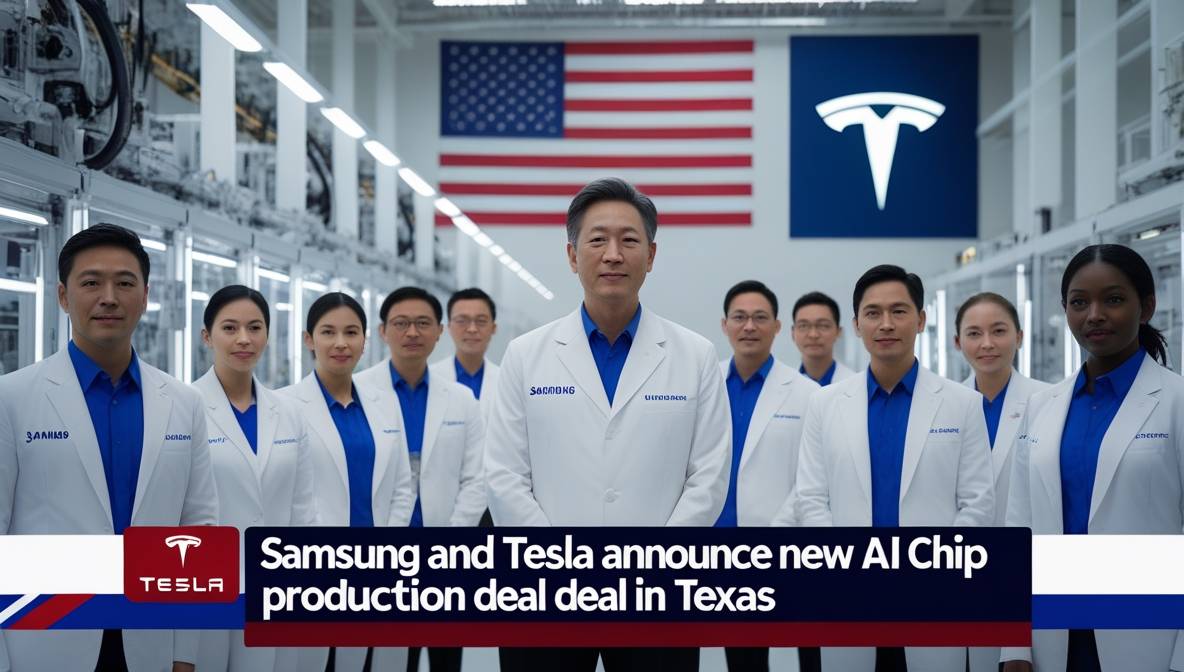Samsung Electronics reports a 55% drop in Q2 2025 profit due to AI chip export curbs and HBM delays, but a $16.5B Tesla deal and new trade deal may fuel recovery. Samsung Q2 2025 profit, Samsung AI chips export restrictions, Tesla Samsung chip deal
Profit Hit by AI Export Curbs and Chip Delays
Samsung Electronics has reported a sharp 55% year-over-year drop in operating profit for Q2 2025 — marking its worst quarterly performance in the past six quarters. The decline is largely attributed to AI chip export restrictions imposed by the U.S. government and internal delays in high-bandwidth memory (HBM) deployment. The South Korean tech giant is under pressure from global rivals and increasing regulatory scrutiny.
Financial Summary: Revenue Slightly Up, Profit Down
The company’s Q2 operating profit came in at ₩4.7 trillion (approx. $3.37 billion), down from ₩10.6 trillion in Q2 2024. Surprisingly, revenue still saw a modest 0.7% year-over-year increase, primarily supported by Samsung’s display and consumer electronics divisions. But this growth wasn’t enough to offset the steep losses from its semiconductor segment, which has long been the company’s core revenue driver.
Chip Trouble: Delays, Export Limits & Lost Clients
At the heart of the downturn is the delay in commercial deployment of Samsung’s next-gen HBM3E chips, which are crucial for powering AI servers and data centers. Competitor TSMC and SK Hynix have made quicker strides, with both securing contracts from key players like Nvidia and AMD.
Samsung, on the other hand, lost out on multiple Nvidia contracts, mainly due to performance and heat dissipation issues in its HBM3E prototypes. Making matters worse, U.S. export controls targeting China and select AI-related components have halted several pending shipments, putting Samsung’s short-term growth trajectory at risk.
The company also faces rising competition from emerging Chinese chipmakers, which are benefiting from government support and local demand.
Tesla Partnership: A $16.5 Billion Lifeline
In a strategic move to diversify its foundry business, Samsung has secured a $16.5 billion deal with Tesla to manufacture AI‑6 automotive chips starting in 2026. These advanced chips will power Tesla’s next-gen autonomous driving systems and in-car AI assistants.
Production will be based at Samsung’s Texas fabrication facility, ensuring compliance with U.S. trade rules and potentially opening doors for more deals with American tech firms. The Tesla contract is being seen as a critical long-term cushion that could help offset current semiconductor losses.
Trade Deal Framework: Tariff Clarity Helps
Adding some optimism to Samsung’s future is the new 15% U.S. semiconductor tariff framework, which was finalized earlier this month. The revised policy provides clearer guidelines on export eligibility and compliance, which may reduce shipment delays and make long-term planning easier for Samsung and its clients.
Analysts believe that this development could help restore investor confidence, especially among U.S.-based clients concerned about supply chain disruptions.
Company Outlook: Recovery Ahead?
Despite the disappointing Q2 results, Samsung’s management remains cautiously optimistic. Chief Financial Officer Park Hark-kyu noted that the company expects AI-chip demand to rebound in the second half of 2025, especially from cloud computing giants like Google Cloud, Amazon AWS, and Microsoft Azure.
Samsung is also preparing for HBM4 shipments, which may offer a performance edge over rivals and help regain lost ground. Additionally, a stock buyback plan worth ₩2.5 trillion ($1.8 billion) is being initiated to support the share price and restore market confidence.
The company is investing in internal R&D acceleration, strengthening its AI-focused product pipeline, and expanding capacity in the U.S. and South Korea to better align with geopolitical supply demands.
Conclusion: A Rough Quarter, But a Strategic Path Forward
While Samsung’s Q2 2025 earnings reflect serious short-term challenges, its strategic partnership with Tesla, improved U.S. trade alignment, and forward-looking AI-chip roadmap offer a realistic path to recovery.
If the company can execute its foundry strategy, regain lost AI-chip clients, and fix technical delays in HBM deployment, it still stands a chance to reclaim semiconductor leadership by late 2025 or early 2026.
For now, investors and stakeholders will be watching closely to see if Samsung can navigate these industry shifts and turn today’s plunge into tomorrow’s comeback.
Why did Samsung’s Q2 2025 profit drop by 55%?
Samsung’s profit fell due to delays in high-bandwidth memory (HBM) chip development, U.S. export restrictions on AI components, and lost contracts with major AI clients like Nvidia.
What is Samsung’s new $16.5 billion deal with Tesla about?
Samsung will manufacture AI-6 chips for Tesla’s next-gen autonomous vehicles, starting in 2026. The deal will use Samsung’s Texas foundry to comply with U.S. trade laws.
How are U.S. trade policies impacting Samsung’s chip business?
Recent U.S. export controls have disrupted Samsung’s AI chip shipments to China. However, a new 15% tariff framework offers clarity for future exports and planning.
Can Samsung recover in the second half of 2025?
Yes. Samsung expects a rebound in AI-chip demand, HBM4 launches, and support from U.S. tech firms like Google and Microsoft to drive recovery
